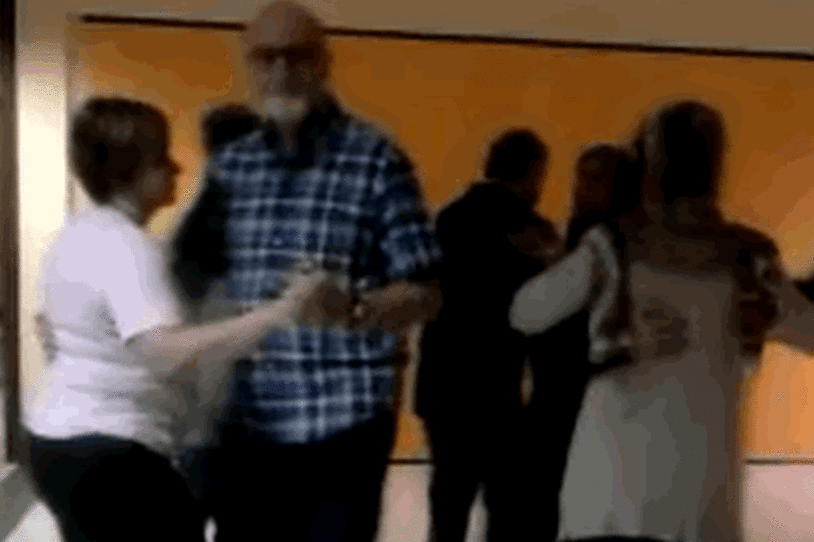reposted from https://www.michaeljfox.org/news/italian-doctors-love-irish-music-inspires-parkinsons-disease-clinical-trial
Italian Doctor’s Love for Irish Music Inspires Parkinson’s Disease Clinical Trial

Fox Meeting Notes: We report on the latest news in Parkinson’s disease research, live from the Movement Disorder Society International Congress in Dublin, Ireland.
About a year ago, on one of his frequent trips to his beloved County Clare, Dr. Daniele Volpe, of Venice, Italy watched a man walk into a bar. Dr. Volpe was playing guitar in an Irish folk band, but he paused as he noticed the man’s slow, halting gait. These symptoms were familiar to Dr. Volpe – He works in a clinic that specializes in physiotherapy designed to help people with Parkinson’s disease (PD).
As Dr. Volpe resumed playing, he noticed the man rise from his seat in the bar, and he began to dance – traditional Irish set dance, he would later learn. Dr. Volpe smiled before the proverbial light went on in his noggin – could Irish set dance work as therapy for people struggling with the motor symptoms of PD? It was worth a shot. So, at last year’s Movement Disorders Society congress, he brought up the idea with the leading Irish neurologist Dr. Timothy Lynch, who was quickly also hooked.
Fast forward one year to this week in Dublin. That initial nugget culled from a bar in County Clare has turned into positive results from an observational study. It also became an MDS Congress performance by a team of Venetian Irish set dancers who all have PD.
We sat down with Dr. Volpe between meetings here to learn a little bit more about his love for Irish music, and what set dancing (and other forms of exercise) could mean for people living with PD.
Please note: The Michael J. Fox Foundation does not endorse any one particular therapy or treatment regimen, and we encourage all patients to discuss therapeutic options, including those involving exercise, with their treating physicians.
MJFF: Tell us about how you found your way to that bar in County Clare.
DV: I love Ireland, it is such a beautiful country, and I adore their music. I come to County Clare twice a year to play guitar in an Irish folk band, and on that day, I was playing alongside the famous banjo player Charlie Piggott. I noticed that this man used a cane to walk into the bar. But then he started dancing without any difficulty. I was impressed. I also noticed that he was using a real dance step, and immediately I thought that his steps could be particularly interesting when thinking about improving gait.
MJFF: What do you mean by the fact that the steps were “particularly interesting for improving gait?”
DV: First of all, there is much research that says that exercise in general is good for people with PD. But specifically, many with Parkinson’s have difficulty changing direction. Irish set dance allows people with PD to overcome freezing of gait when turning by maintaining a consistent step length (these steps are called “reel steps” in Irish dancing). Reel steps also help them to better transfer their weight more naturally. I believe this dancing may help people with Parkinson’s to re-learn how to make these movements.
MJFF: You also talk about “acoustic cues” being useful for people struggling with PD motor symptoms. What does this mean?
DV: In Parkinson’s disease, we’ve found that people move better sometimes under certain conditions. For example, they may see something take place in front of them that inspires them to walk forward, or, they may hear something that helps them to move better. Irish folk music has a very strong rhythm, so it may be that this helps the brain to recognize it’s time to move. Another factor which shouldn’t be discounted is the sense of community that dancing and music instills in patients. It can be a real motivating factor for people with PD who may not want to dance. By getting them to exercise, we are already making an important first step.
MJFF: Tell us more about the study’s findings on the whole, and what they could mean for people with PD.
DV: We recruited 24 subjects for the study, which took place over the course of six months. Twelve underwent traditional physiotherapy, while 12 more took Irish set dance courses (for two hours weekly) which I designed with the help of an Irish set dance studio in Venice (yes, it’s true!). I wanted to make sure that the steps were accurate from the perspective of physiotherapy. Then, we ran both groups through some clinical tests and gait analysis. Both experienced significant improvements in the Unified Parkinson’s Disease Rating Scale (UPDRS), Berg Balance Scale (BBS), and in quality of life measurements like number of falls and walking speed. But in each case, the Irish set dance group improved more. Also, only the dance group experienced significant improvement in self-reported freezing of gait and in the Time Up and Go test (TUG). T he dance group also showed a significant improvement in the Caregiver Burden Inventory (CBI), which suggests the high social value of Irish set dance. The results were very intriguing.
MJFF: What’s next? More Irish step dance at next year’s Congress?
DV: I hope so! This, of course, was a small study, so we’ll need to a real recruit more people for a large scale study to confirm the results. We’re also putting together an instruction manual which shows how you can implement Irish set dance into a real physiotherapeutic program incorporating evidence based medicine. There’s an Irish festival in Venice in 2013, and I’d love for us to be able to put on a larger scale performance then.
No comments:
Post a Comment